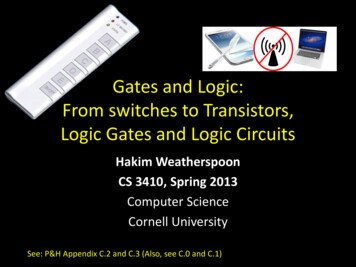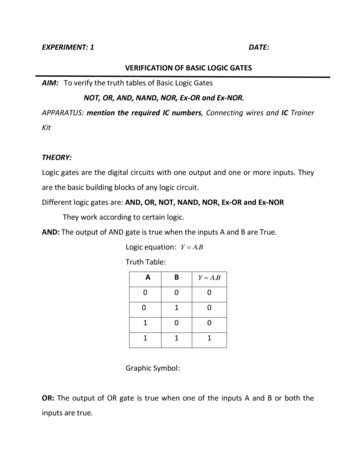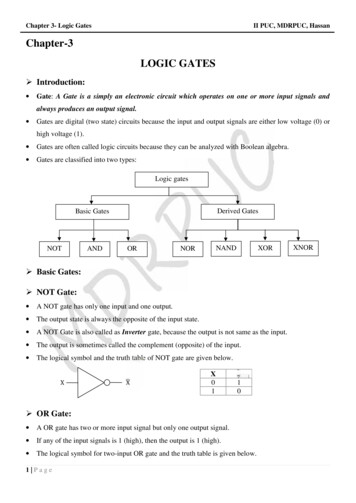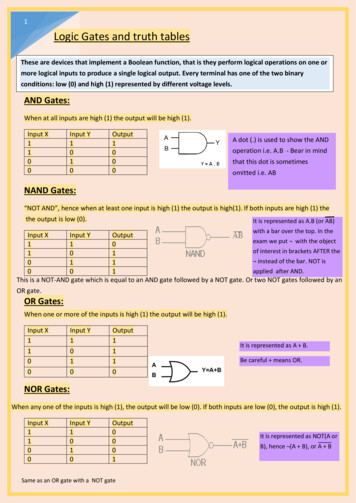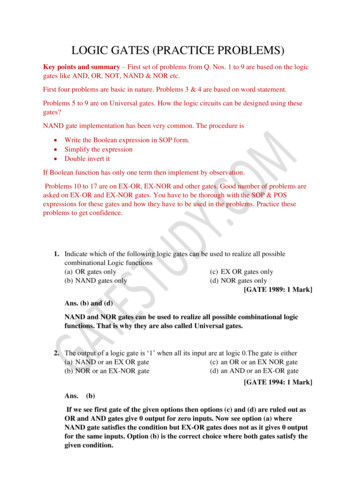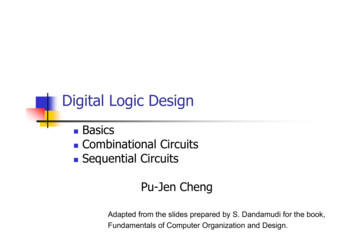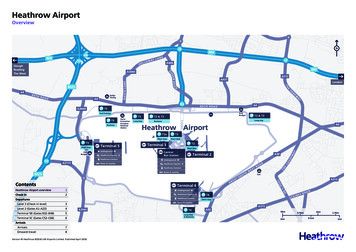
Transcription
CHAPTER6DESIGNING COMBINATIONALLOGIC GATES IN CMOSIn-depth discussion of logic families in CMOS—static and dynamic, pass-transistor, nonratioed and ratioed logicnOptimizing a logic gate for area, speed, energy, or robustnessnLow-power and high-performance circuit-design techniques6.1Introduction6.2Static CMOS Design6.36.3.2Speed and Power Dissipation ofDynamic Logic6.3.3Issues in Dynamic Design6.3.4Cascading Dynamic Gates6.2.1Complementary CMOS6.5Leakage in Low Voltage Systems6.2.2Ratioed Logic6.4Perspective: How to Choose a Logic Style6.2.3Pass-Transistor Logic6.6Summary6.7To Probe Further6.8Exercises and Design ProblemsDynamic CMOS Design6.3.1Dynamic Logic: Basic Principles197
1986.1DESIGNING COMBINATIONAL LOGIC GATES IN CMOSChapter 6IntroductionThe design considerations for a simple inverter circuit were presented in the previouschapter. In this chapter, the design of the inverter will be extended to address the synthesisof arbitrary digital gates such as NOR, NAND and XOR. The focus will be on combinational logic (or non-regenerative) circuits that have the property that at any point in time,the output of the circuit is related to its current input signals by some Boolean expression(assuming that the transients through the logic gates have settled). No intentional connection between outputs and inputs is present.In another class of circuits, known as sequential or regenerative circuits —to be discussed in a later chapter—, the output is not only a function of the current input data, butalso of previous values of the input signals (Figure 6.1). This is accomplished by connecting one or more outputs intentionally back to some inputs. Consequently, the circuit“remembers” past events and has a sense of history. A sequential circuit includes a combinational logic portion and a module that holds the state. Example circuits are registers,counters, oscillators, and alLogicCircuitOutState(a) Combinational(b) SequentialFigure 6.1 High level classification of logic circuits.There are numerous circuit styles to implement a given logic function. As with theinverter, the common design metrics by which a gate is evaluated include area, speed,energy and power. Depending on the application, the emphasis will be on different metrics(e.g., in high performance processor, the switching speed of digital circuits is the primarymetric while in a battery operated circuit it is the energy dissipation). In addition to thesemetrics, robustness to noise is also a very important consideration. We will see that certainlogic styles (e.g., Dynamic logic) can significantly improve performance, but can be moresensitive to noise. Recently, power dissipation has also become a very important requirement and significant emphasis is placed on understanding the sources of power andapproaches to deal with power.6.2Static CMOS DesignThe most widely used logic style is static complementary CMOS. The static CMOS styleis really an extension of the static CMOS inverter to multiple inputs. In review, the primary advantage of the CMOS structure is robustness (i.e, low sensitivity to noise), goodperformance, and low power consumption (with no static power consumption). As we will
Section 6.2Static CMOS Design199see, most of those properties are carried over to large fan-in logic gates implemented usingthe same circuit topology.The complementary CMOS circuit style falls under a broad class of logic circuitscalled static circuits in which at every point in time (except during the switching transients), each gate output is connected to either VDD or Vss via a low-resistance path. Also,the outputs of the gates assume at all times the value of the Boolean function implementedby the circuit (ignoring, once again, the transient effects during switching periods). This isin contrast to the dynamic circuit class, that relies on temporary storage of signal values onthe capacitance of high-impedance circuit nodes. The latter approach has the advantagethat the resulting gate is simpler and faster. On the other hand, its design and operation aremore involved than those of its static counterpart, due to an increased sensitivity to noise.In this section, we sequentially address the design of various static circuit flavorsincluding complementary CMOS, ratioed logic (pseudo-NMOS and DCVSL), and passtransistor logic. The issues of scaling to lower power supply voltages and threshold voltages will also be dealt with.6.2.1Complementary CMOSA static CMOS gate is a combination of two networks, called the pull-up network (PUN)and the pull-down network (PDN) (Figure 6.2). The figure shows a generic N input logicgate where all inputs are distributed to both the pull-up and pull-down networks. The function of the PUN is to provide a connection between the output and VDD anytime the outputof the logic gate is meant to be 1 (based on the inputs). Similarly, the function of the PDNis to connect the output to VSS when the output of the logic gate is meant to be 0. The PUNand PDN networks are constructed in a mutually exclusive fashion such that one and onlyone of the networks is conducting in steady state. In this way, once the transients have settled, a path always exists between VDD and the output F, realizing a high output (“one”),or, alternatively, between VSS and F for a low output (“zero”). This is equivalent to statingthat the output node is always a low-impedance node in steady state.In constructing the PDN and PUN networks, the following observations should bekept in mind:VDDIn1In2PUNInNpull-up: make a connection from VDD to F whenF(In1,In2, . Inn) 1F (In1,In2, . Inn)In1In2PDNInNpull-down: make a connection from VDD to Vss whenF(In1,In2, . Inn) 0VSSFigure 6.2 Complementary logic gate as a combination of a PUN (pull-up network) and aPDN (pull-down network).
200DESIGNING COMBINATIONAL LOGIC GATES IN CMOSChapter 6 A transistor can be thought of as a switch controlled by its gate signal. An NMOSswitch is on when the controlling signal is high and is off when the controlling signalis low. A PMOS transistor acts as an inverse switch that is on when the controllingsignal is low and off when the controlling signal is high. The PDN is constructed using NMOS devices, while PMOS transistors are used inthe PUN. The primary reason for this choice is that NMOS transistors produce“strong zeros,” and PMOS devices generate “strong ones”. To illustrate this, consider the examples shown in Figure 6.3. In Figure 6.3a, the output capacitance is initially charged to VDD. Two possible discharge scenario’s are shown. An NMOSdevice pulls the output all the way down to GND, while a PMOS lowers the outputno further than VTp — the PMOS turns off at that point, and stops contributing discharge current. NMOS transistors are hence the preferred devices in the PDN. Similarly, two alternative approaches to charging up a capacitor are shown in Figure6.3b, with the output load initially at GND. A PMOS switch succeeds in chargingthe output all the way to VDD, while the NMOS device fails to raise the output aboveVDD-VTn. This explains why PMOS transistors are preferentially used in a PUN.OutVDDVDD 0OutVDD VTp CLCL(a) pulling down a node using NMOS and PMOS switchesVDD0 VDD0 VDD- VTnOutOutCLCL(b) pulling down a node using NMOS and PMOS switchesFigure 6.3 Simple examples illustrate why an NMOS should be used as a pulldown transistor, while a PMOS should be used as a pull-up device. A set of construction rules can be derived to construct logic functions (Figure 6.4).NMOS devices connected in series corresponds to an AND function. With all theinputs high, the series combination conducts and the value at one end of the chain istransfered to the other end. Similarly, NMOS transistors connected in parallel represent an OR function. A conducting path exists between the output and input terminalif at least one of the inpurs is high. Using similar arguments, construction rules forPMOS networks can be formulated. A series connection of PMOS conducts if both
Section 6.2Static CMOS DesignSeries Combination201BAAConducts if A · B(a) seriesBParallel CombinationConducts if A B(b) parallelFigure 6.4 NMOS logic rules — series devices implement an AND, and parallel devicesimplement an OR.inputs are low, representing a NOR function (A.B A B), while PMOS transistorsin parallel implement a NAND (A B A·B. Using De Morgan’s theorems ((A B) A·B and A·B A B), it can be shown thatthe pull-up and pull-down networks of a complementary CMOS structure are dualnetworks. This means that a parallel connection of transistors in the pull-up networkcorresponds to a series connection of the corresponding devices in the pull-downnetwork, and vice versa. Therefore, to construct a CMOS gate, one of the networks(e.g., PDN) is implemented using combinations of series and parallel devices. Theother network (i.e., PUN) is obtained using duality principle by walking the hierarchy, replacing series subnets with parallel subnets, and parallel subnets with seriessubnets. The complete CMOS gate is constructed by combining the PDN with thePUN. The complementary gate is naturally inverting, implementing only functions such asNAND, NOR, and XNOR. The realization of a non-inverting Boolean function(such as AND OR, or XOR) in a single stage is not possible, and requires the addition of an extra inverter stage. The number of transistors required to implement an N-input logic gate is 2N.Example 6.1 Two input NAND GateFigure 6.5 shows a two-input NAND gate (F A·B). The PDN network consists of twoNMOS devices in series that conduct when both A and B are high. The PUN is the dual network, and consists of two parallel PMOS transistors. This means that F is 1 if A 0 or B 0,which is equivalent to F A·B. The truth table for the simple two input NAND gate is givenin Table 6.1. It can be verified that the output F is always connected to either VDD or GND,but never to both at the same time.Example 6.2 Synthesis of complex CMOS GateUsing complementary CMOS logic, consider the synthesis of a complex CMOS gate whosefunction is F D A· (B C). The first step in the synthesis of the logic gate is to derive thepull-down network as shown in Figure 6.6a by using the fact that NMOS devices in seriesimplements the AND function and parallel device implements the OR function. The next stepis to use duality to derive the PUN in a hierarchical fashion. The PDN network is broken intosmaller networks (i.e., subset of the PDN) called sub-nets that simplify the derivation of thePUN. In Figure 6.6b, the subnets (SN) for the pull-down network are identified At the toplevel, SN1 and SN2 are in parallel so in the dual network, they will be in series. Since SN1
202DESIGNING COMBINATIONAL LOGIC GATES IN CMOSChapter 6VDDTable 6.1Truth Table for 2 input NANDABFAABF001011101110BFigure 6.5 Two-input NAND gate in complementary static CMOS style.consists of a single transistor, it maps directly to the pull-up network. On the other hand, weneed to recursively apply the duality rules to SN2. Inside SN2, we have SN3 and SN4 inseries so in the PUN they will appear in parallel. Finally, inside SN3, the devices are in parallel so they will appear in series in the PUN. The complete gate is shown in Figure 6.6c. Thereader can verify that for every possible input cobmination, there always exists a path toeither VDD or GND.VDDVDDCSN1DDBCBSN2AAASN4FFSN3BDCF(a) pull-down network(b) Deriving the pull-up networkhierarchically by identifyingsubnetsADBCFigure 6.6 Complex complementary CMOS gate.(c) complete gateStatic Properties of Complementary CMOS GatesComplementary CMOS gates inherit all the nice properties of the basic CMOS inverter,discussed earlier.They exhibit rail to rail swing with VOH VDD and VOL GND. The circuits also have no static power dissipation, since the circuits are designed such that thepull-down and pull-up networks are mutually exclusive. The analysis of the DC voltagetransfer characteristics and the noise margins is more complicated then for the inverter, asthese parameters depend upon the data input patterns applied to gate.Consider the static two-input NAND gate shown in Figure 6.7. Three possible inputcombinations switch the output of the gate from high-to-low: (a) A B 0 1, (b) A 1,
Section 6.2Static CMOS Design2033.0VDDAM3BM4A B 0 1FM2AVout, V2.0A 1, B 0 11.0intB 1, A 0 1M1B0.00.01.02.03.0Vin, VFigure 6.7 The VTC of a two-input NAND is data-dependent. NMOS devices are0.5µm/0.25µm while the PMOS devices are sized at 0.75µm/0.25µm.B 0 1, and (c) B 1, A 0 1. The resulting voltage transfer curves display significant differences. The large variation between case (a) and the others (b & c) is explainedby the fact that in the former case both transistors in the pull-up network are on simultaneously for A B 0, representing a strong pull-up. In the latter cases, only one of the pullup devices is on. The VTC is shifted to the left as a result of the weaker PUN.The difference between (b) and (c) results mainly from the state of the internal nodeint between the two NMOS devices. For the NMOS devices to turn on, both gate-tosource voltages must be above VTn, with VGS2 VA - VDS1 and VGS1 VB. The thresholdvoltage of transistor M2 will be higher than transistor M1 due to the body effect. Thethreshold voltages of the two devices are given by:V Tn2 V tn0 γ ( (2φ f Vint ) –VTn1 V tn02φ f )(6.1)(6.2)For case (b), M3 is turned off, and the gate voltage of M2 is set to VDD. To a firstorder, M2 may be considered as a resistor in series with M1. Since the drive on M2 is large,this resistance is small and has only a small effect on the voltage transfer characteristics.In case (c), transistor M1 acts as a resistor, causing body effect in M2. The overall impactis quite small as seen from the plot.Design ConsiderationThe important point to take away from the above discussion is that the noise margins are inputpattern dependent. For the above example, a smaller input glitch will cause a transition at theoutput if only one of the inputs makes a transition. Therefore, this condition has a lower lownoise margin. A common practice when characterizing gates such as NAND and NOR is to
204DESIGNING COMBINATIONAL LOGIC GATES IN CMOSChapter 6connect all the inputs together. This unfortunately does not represent the worst-case staticbehavior. The data dependencies should be carefully modeled.Propagation Delay of Complementary CMOS GatesThe computation of propagation delay proceeds in a fashion similar to the static inverter.For the purpose of delay analysis, each transistor is modeled as a resistor in series with anideal switch. The value of the resistance is dependent on the power supply voltage and anequivalent large signal resistance, scaled by the ratio of device width over length, must beused. The logic is transformed into an equivalent RC network that includes the effect ofinternal node capacitances. Figure 6.8 shows the two-input NAND gate and its equivalentRC switch level model. Note that the internal node capacitance Cint —attributable to thesource/drain regions and the gate overlap capacitance of M2/M1— is included. While complicating the analysis, the capacitance of the internal nodes can have quite an impact insome networks such as large fan-in gates.VDDVDDAM3RPBM4ARPBFFAM2RNCLBRNBM1(a) Two-input NANDCintA(b) RC equivalent modelFigure 6.8 Equivalent RC model for a NAND gate.We will initially ignore the effect of the internal capacitance (for a first pass). Themost important observation is that delay is also dependent on the input patterns. Considerfor instance the low-to-high transition. Three possible input scenarios can be identified forcharging the output to VDD. If both inputs are driven low, the two PMOS devices are on.The delay in this case is 0.69 (Rp/2) CL, since the two resistors are in parallel. This isnot the worst-case low-to-high transition, which occurs when only one device turns on,and is given by 0.69 Rp CL. For the pull-down path, the output is discharged only ifboth A and B are switched high, and the delay is given by 0.69 (2RN) CL to a firstorder. In other words, adding devices in series slows down the circuit, and devices must bemade wider to avoid a performance penalty. When sizing the transistors in a gate withmultiple fan-in’s, we should pick the combination of inputs that triggers the worst-caseconditions.For example, for a NAND gate to have the same pull-down delay delay (tphl) as aminimum sized inverter (NMOS: 0.375µm/0.25µm and PMOS: 1.125µm/0.25µm), the
Section 6.2Static CMOS Design205NMOS devices in the NAND stack must be made twice as large (i.e., NMOS of NANDshould be 0.75µm/0.25µm) so that the equivalent resistance the NAND pull-down is thesame as the inverter. The PMOS device can remain unchanged.This first-order analysis assumes that the extra capacitance introduced by wideningthe transistors can be ignored. This is not a good assumption in general, but allows for areasonable first cut at device sizing.Example 6.3 Delay dependence on input patternsConsider the NAND gate of Figure 6.8a. Assume NMOS and PMOS devices of0.5µm/0.25µm and 0.75µm/0.25µm, respectively. This sizing should result in approximately equalworst-case rise and fall times (since the effective resistance of the pull-down is designed to be equalto the pull-up resistance).Figure 6.9 shows the simulated low-to-high delay for different input patterns. As expected,the case where both inputs transition go low (A B 1 0) results in a smaller delay, compared tothe case where only one input is driven low. Notice that the worst-case low-to-high delay dependsupon which input (A or B) goes low. The reason for this involves the internal node capacitance of thepull-down stack (i.e., the source of M2). For the case that B 1 and A transitions from 1 0, the pullup PMOS device only has to charge up the output node capacitance since M2 is turned off. On theother hand, for the case where A 1 and B transitions from 1 0, the pull-up PMOS device has tocharge up the sum of the output and the internal node capacitances, which slows down the transition.3.0A B 1 0Voltage, V2.0A 1, B 1 01.0A 1 0, B 10.0-1.00100200time, ps300400Input DataPatternDelay(pS)A B 0 169A 1, B 0 162A 0 1, B 150A B 1 035A 1, B 1 076A 1 0, B 157Figure 6.9 Example showing the delay dependence on input patterns.The table in Figure 6.9 shows a compilation of various delays for this circuit. The first-ordertransistor sizing indeed provides approximately equal rise and fall delays. An important point to noteis that the high-to-low propagation delay depends on the state of the internal nodes. For example,when both inputs transition from 0 1, it is important to establish the state of the internal node. Theworst-case happens when the internal node is charged up to VDD-VTn. The worst case can be ensuredby pulsing the A input from 1 0 1, while input B only makes the 0 1. In this way, the internalnode is initialized properly.The important point to take away from this example is that estimation of delay can be fairlycomplex, and requires a careful consideration of internal node capacitances and data patterns. Caremust be taken to model the worst-case scenario in the simulations. A brute force approach thatapplies all possible input patterns, may not always work as it is important to consider the state ofinternal nodes.
206DESIGNING COMBINATIONAL LOGIC GATES IN CMOSChapter 6The CMOS implementation of a NOR gate (F A B) is shown in Figure 6.10. Theoutput of this network is high, if and only if both inputs A and B are low. The worst-casepull-down transition happens when only one of the NMOS devices turns on (i.e., if eitherA or B is high). Assume that the goal is to size the NOR gate such that it has approximately the same delay as an inverter with the following device sizes: NMOS0.5µm/0.25µm and PMOS 1.5µm/0.25µm. Since the pull-down path in the worst case is asingle device, the NMOS devices (M1 and M2) can have the same device widths as theNMOS device in the inverter. For the output to be pulled high, both devices must beturned on. Since the resistances add, the devices must be made two times larger comparedto the PMOS in the inverter (i.e., M3 and M4 must have a size of 3µm/0.25µm). SincePMOS devices have a lower mobility relative to NMOS devices, stacking devices in seriesmust be avoided as much as possible. A NAND implementation is clearly prefered over aNOR implementation for implementing generic e 6.10Sizing of a NOR gate to produce the same delay as an inverter with size ofNMOS: 0.5µm/0.25µm and PMOS: 1.5µm/0.25µm.Problem 6.1Transistor Sizing in Complementary CMOS GatesDetermine the transistor sizes of the individual transistors in Figure 6.6c such that it hasapproximately the same tplh and tphl as a inverter with the following sizes: NMOS:0.5µm/0.25µm and PMOS: 1.5µm/0.25µm.So far in the analysis of propagation delay, we have ignored the effect of internalnode capacitances. This is often a reasonable assumption for a first-order analysis. However, in more complex logic gates that have large fan-in, the internal node capacitancescan become significant. Consider a 4-input NAND gate as shown in Figure 6.11, whichshows the equivalent RC model of the gate, including the internal node capacitances. Theinternal capacitances consist of the junction capacitance of the transistors, as well as thegate-to-source and gate-to-drain capacitances. The latter are turned into capacitances toground using the Miller equivalence. The delay analysis for such a circuit involves solvingdistributed RC networks, a problem we already encountered when analyzing the delay ofinterconnect networks. Consider the pull-down delay of the circuit. The output is discharged when all inputs are driven high. The proper initial conditions must be placed onthe internal nodes (this is, the internal nodes must be charged to VDD-VTN) before theinputs are driven high.
Section 6.2Static CMOS Design207VDDVDDAM5 BM7 DM6 gure 6.11Four input NAND gate along with the internal node capacitances.The propagation delay can be computed using the Elmore delay model and isapproximated as:tpHL 0.69 ( R C 1 ( R R ) C ( R R R ) C ( R R R R ) C L )112212331234(6.3)Notice that the resistance of M1 appears in all the terms, which makes this deviceespecially important when attempting to minimize delay. Assuming that all NMOSdevices have an equal size, Eq. (6.3) simplifies tot pHL 0.69R N ( C 1 2 C 2 3 C 3 4 C L )(6.4)Example 6.4 A Four-Input Complementary CMOS NAND GateIn this example, the intrinsic propagation delay of the 4 input NAND gate (without any loading) is evaluated using hand analysis and simulation. Assume that all NMOS devices have a W/L of0.5µm/0.25µm, and all PMOS devices have a device size of 0.375µm/0.25µm. The layout of a fourinput NAND gate is shown in Figure 6.12. The devices are sized such that the worst case rise andfall time are approximately equal (to first order ignoring the internal node capacitances).Using techniques similar to those employed for the CMOS inverter in Chapter 3, the capacitances values can be computed from the layout. Notice that in the pull-up path, the PMOS devicesshare the drain terminal in order to reduce the overall parasitic contribution to the the output. Usingour standard design rules, the area and perimeter for various devices can be easily computed asshown in Table 6.1In this example, we will focus on the pull-down delay, and the capacitances will be computedfor the high-to-low transition at the output. While the output make a transition from VDD to 0, theinternal nodes only transition from VDD-VTn to GND. We would need to linearlize the internal junction capacitances for this voltage transition, but, to simplify the analysis, we will use the same Kefffor the internal nodes as for the output node.It is assumed that the output connects to a single, minimum-size inverter. The effect of intracell routing, which is small, is ignored. The different contributions are summarized in Table 6.2.For the NMOS and PMOS junctions, we use Keq 0.57, Keqsw 0.61, and Keq 0.79, Keqsw 0.86, respectively. Notice that the gate-to-drain capacitance is multiplied by a factor of two forall internal nodes and the output node to account for the Miller effect (this ignores the fact thatthe internal nodes have a slightly smaller swing due to the threshold drop).
208DESIGNING COMBINATIONAL LOGIC GATES IN CMOSChapter 6VDDOutGNDABCDFigure 6.12 Layout a four-input NAND gate in complementary CMOS.Table 6.1Area and perimeter of various transistors for 4 input NAND gate.TransistorW (µm)AS (µm2)AD (µm2)PS .87580.3750.2968750.1718751.8750.875Using Eq. (6.4), we can compute the propagation delay as:13KΩ- ( 0.85fF 2 0.85fF 3 0.85fF 4 3.47 fF ) 85 p st pHL 0.69 ------------- 2 (6.5)The simulated delay for this particular transition was found to be 86 psec! The hand analysisgives a fairly accurate estimate given all assumptions and linearizations made. For example, weassume that the gate-source (or gate-drain) capacitance only consists of the overlap component. Thisis not entirely the case, as during the transition some other contributions come in place dependingupon the operating region. Once again, the goal of hand analysis is not to provide a totally accuratedelay prediction, but rather to give intuition into what factors influence the delay and to aide in initial transistor sizing. Accurate timing analysis and transistor optimization is usually done usingSPICE. The simulated worst-case low-to-high delay time for this gate was 106ps.While complementary CMOS is a very robust and simple approach for implementing logic gates, there are two major problems associated with using this style as the com-
Section 6.2Static CMOS Design209Table 6.2 Computation of capacitances (for high-to-low transition at the output). The circuitshows the intrinsic delay of the gate with no extra loading. Any fan-out capacitance wouldsimply be added to the CL term.CapacitorContributions (H L)Value (fF) (H L)C1Cd1 Cs2 2 * Cgd1 2 * Cgs2(0.57 * 0.0625 * 2 0.61 * 0.25 * 0.28) (0.57 * 0.0625 * 2 0.61 * 0.25* 0.28) 2 * (0.31 * 0.5) 2 * (0.31 * 0.5) 0.85fFC2Cd2 Cs3 2 * Cgd2 2 * Cgs3(0.57 * 0.0625 * 2 0.61 * 0.25 * 0.28) (0.57 * 0.0625 * 2 0.61 * 0.25* 0.28) 2 * (0.31 * 0.5) 2 * (0.31 * 0.5) 0.85fFC3Cd3 Cs4 2 * Cgd3 2 * Cgs4(0.57 * 0.0625 * 2 0.61 * 0.25 * 0.28) (0.57 * 0.0625 * 2 0.61 * 0.25* 0.28) 2 * (0.31 * 0.5) 2 * (0.31 * 0.5) 0.85fFCLCd4 2 * Cgd4 Cd5 Cd6 Cd7 Cd8 (0.57 * 0.3125 * 2 0.61 * 1.75 *0.28) 2 * Cgd5 2 * Cgd6 2 * Cgd7 2 * Cgd8 2 * (0.31 * 0.5) 4 * (0.79 * 0.171875* 1.9 0.86 Cd4 4 * Cd5 4 * 2 * Cgd6* 0.875 * 0.22) 4 * 2 * (0.27 * 0.375) 3.47fFplexity of the gate (i.e., fan-in) increases. First, the number of transistors required toimplement an N fan-in gate is 2N. This can result in significant implementation area. Thesecond problem is that propagation delay of a complementary CMOS gate deterioratesrapidly as a function of the fan-in. The large number of transistors (2N) increases the overall capacitance of the gate. For an N-input NAND gate, the output capacitance increaseslinearly with the fan-in since the number of PMOS devices connected to the output nodeincreases linearly with the fan-in. Also, a series connection of transistors in either the PUNor PDN slows the gate as well, because the effective (dis)charging resistance is increased.For the same N-input NAND gate, the effective resistance of the PDN path increases linearly with the fan-in. Since the output capacitance increase linearly and the pull-downresistance increases linearly, the high-to-low delay can increase in a quadratic fashion.The fan-out has a large impact on the delay of complementary CMOS logic as well.Each input to a CMOS gate connects to both an NMOS and a PMOS device, and presentsa load to the driving gate equal to the sum of the gate capacitances.The above observations are summarized by the following formula, which approximates the influence of fan-in and fan-out on the propagation delay of the complementaryCMOS gatet p a 1 FI a 2 FI 2 a 3 FO(6.6)where FI and FO are the fan-in and fan-out of the gate, respectively, and a1, a2 and a3 areweighting factors that are a function of the technology.At first glance, it would appear that the increase in resistance for larger fan-in can besolved by making the devices in the transistor chain wider. Unfortunately, this does notimprove the performance as much as expected, since widening a device also increases itsgate and diffusion capacitances, and has an adverse affect on the gate performance. Forthe N-input NAND gate, the low-to-high delay only increases linearly since the pull-upresistance remains unchanged and only the capacitance increases linearly.
210DESIGNING COMBINATIONAL LOGIC GATES IN CMOSChapter 6Figure 6.13 show the propagation delay for both transitions as a function of fan-inassuming a fixed fan-out (NMOS: 0.5µm and PMOS: 1.5µm). As predicted above, thetpLH increases linearly due to the linearly-increasing value of the output capacitance. Thesimultaneous increase in the pull-down resistance and the load capacitance results in anapproximately quadratic relationship for tpHL. Gates with a fan-in greater than or equal to 4become excessively slow and must be avoided.1250tpHLtp (psec)1000750500tpLH2500246810Fan-in1214Figure 6.13 Propagation delay ofCMOS NAND gate as a
The truth table for the simple two input NAND gate is given in Table 6.1. It can beverified that the output F is always connected to either V DD or GND, but never to both at the same time. Example 6.2 Synthesis of complex CMOS Gate Using complementary CMOS logic, consider the synthesis of
